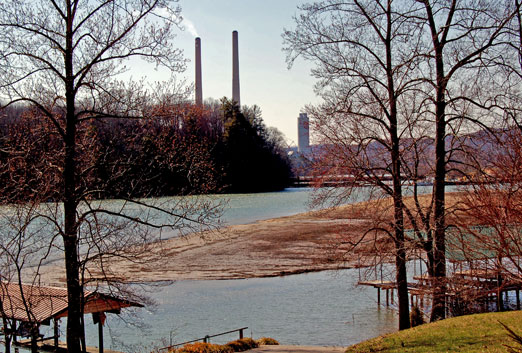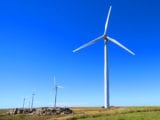
A view of the TVA coal fired power plant at Kingston Tennessee across the Emory River. That is not a natural island in the river. It is an island of toxic coal ash: Glynn Wilson
By Glynn Wilson –
A coalition of 22 states and 7 local governments announced a lawsuit against the Environmental Protection Agency Tuesday over the Trump administration’s proposed new Affordable Clean Energy rule, which rolls back decades of regulations aimed at cleaning up air pollution from coal-fired power plants and virtually erases progress by the Obama administration’s Clean Power Plan.
Maryland Attorney General Brian E. Frosh announced the decision to sue before the U.S. Court of Appeals for the District of Columbia and cited environmental advocates who are calling the Trump plan the “Dirty Power” rule.
Obama’s Clean Power Plan established the first-ever nationwide limits on one of the largest sources of pollution that is causing climate change due to global warming, fossil-fueled power plants.
The new proposed rule rolls back these limits, and according to Frosh and other sources, will have virtually no positive impact on fossil fuel emissions, in fact prolonging the nation’s reliance on polluting, expensive coal power plants and obstructing progress of states toward clean, renewable and affordable electricity.
“The EPA continues to prioritize the coal industry over clean, renewable energy,” Frosh said in his announcement. “The decision to implement the ‘Dirty Power’ rule will have long-lasting effects on public health. It will accelerate climate change at a time when we desperately need action to reverse it.”
The text of the entire ACE rule barely mentions climate change — ignoring the dire threat it poses to public health, the economy, and the environment — and disregards requirements of the federal Clean Air Act. The law requires that limits on air pollutants, such as greenhouse gases, be based on the emissions reductions achievable through the “best system of emission reduction.”
The Trump EPA has ruled out shifting from a coal-fueled generation to less carbon-intensive sources, the most cost-effective, proven and successful approach (i.e., the “best system”) for controlling greenhouse gas emissions.
The 10-state Regional Greenhouse Gas Initiative, a market-based cap-and-trade program in which Maryland participates, has proven to be an effective, cost-efficient model, Frosh said, for reducing power plant emissions of pollution that is causing climate change due to global warming by emitting carbon dioxide into the atmosphere. Power plants in those states have cut emissions by more than 50 percent.
In addition to lowering pollution emissions in those states, between 2015 and 2017, these states saw $1.4 billion of net positive economic activity and the creation of 14,500 new jobs as a result, Frosh said, all while maintaining reliability of service and holding the line on electricity rates.
The “Dirty Power” rule prohibits states from relying on their participation in cap-and-trade programs as a means of complying with the requirements of the Clean Air Act.
The “best system of emission reduction” proposed in the “Dirty Power” rule consists solely of equipment upgrades at coal-fired power plants, he said. Such upgrades will reduce carbon emissions by 2030 by only 0.7 percent more than having no rule at all, according to EPA’s own analysis. The agency has found that emissions of one or more of three pollutants — carbon dioxide (CO2), nitrogen oxides (NOx), and sulfur dioxide (SO2) — will increase in 18 states in 2030 compared to having no rule at all.
“The ‘Dirty Power’ rule’s projected failure to achieve virtually any reductions in power plant emissions is serious,” Frosh said.
The International Energy Agency estimates that climate change pollution from the U.S. power sector must be reduced by 74 percent below 2005 levels by 2030 in order to limit worldwide temperature increase to less than 2 degrees Celsius.
By the EPA’s own estimates, the “Dirty Power” rule falls “woefully short” of hitting this target with a projected reduction of only 35 percent from 2005 levels, Frosh said. Of that, roughly one percent is attributable to the impact of the “Dirty Power” rule and 34 percent is attributable to market factors.
In addition to Attorney General Frosh, the suit is joined by the attorneys general of California, Colorado, Connecticut, Delaware, the District of Columbia, Hawaii, Illinois, Maine, Massachusetts, Michigan, Minnesota, New Jersey, New Mexico, New York, North Carolina, Oregon, Pennsylvania, Rhode Island, Vermont, Virginia, Washington and Wisconsin.
In addition, the chief legal officers of Boulder, Chicago, Los Angeles, New York City, Philadelphia, and South Miami have joined the suit.
Some members of Congress have already indicated they may get involved to invalidate the proposed rule as well, since it is Congress which makes the laws, including the Clean Air Act, passed in 1970 and signed by then-Republican President Richard Nixon.














The cat was let out of the bag by Reagan’s Interior Secretary, James Watt, when he responded to a question about “lawful” destruction of the environment, at a press conference FEW media sources covered-basically he stated that man should “deplete” ALL natural resources for our own use before “Jesus came again (rapture)” as those same sources would, at that time, be forfeited to “dark forces.” This is the playbook of the conservative nutcase religious right and we aren’t going to change it-but it does explain a great deal if you examine it.